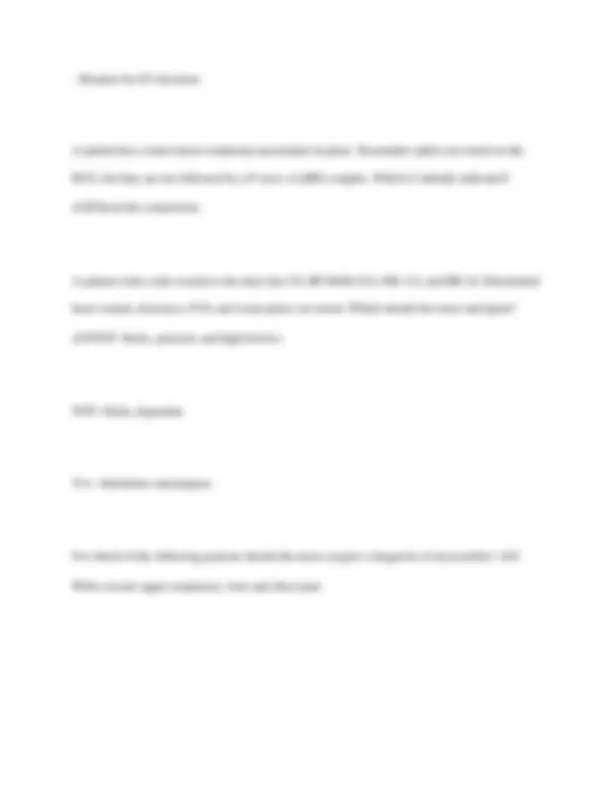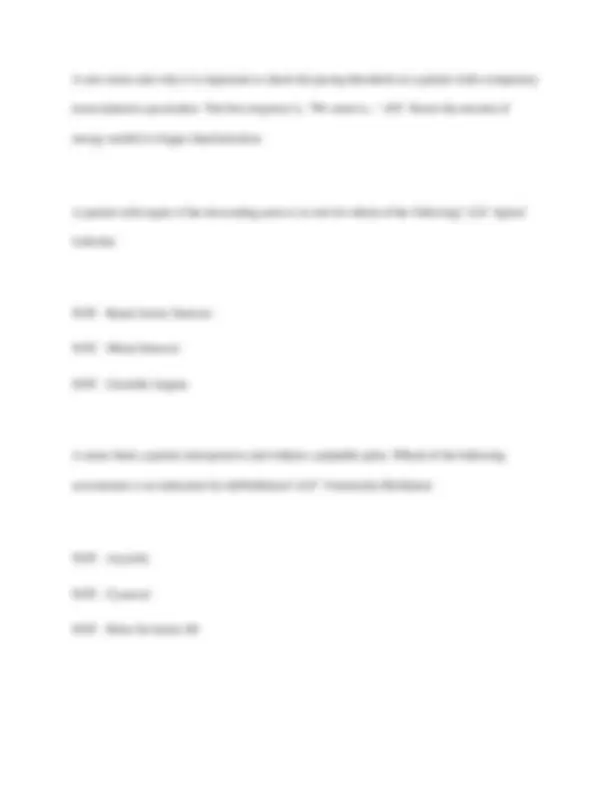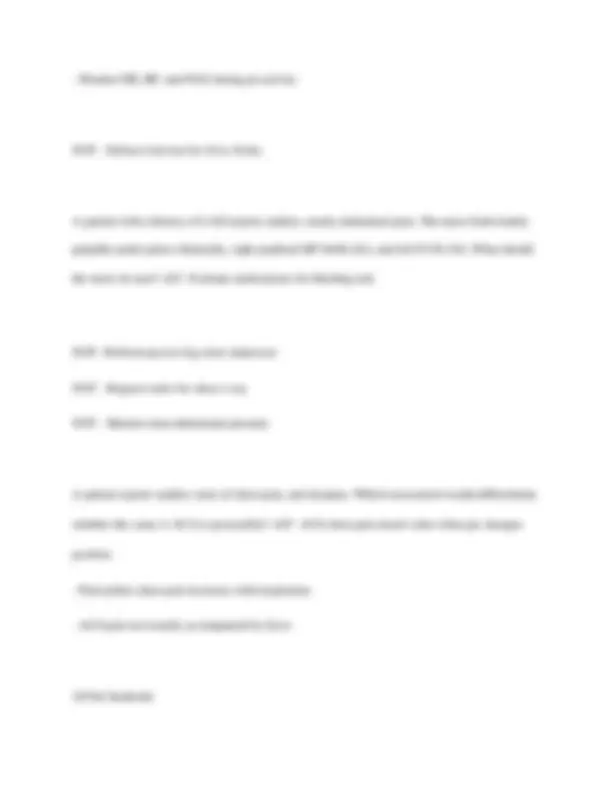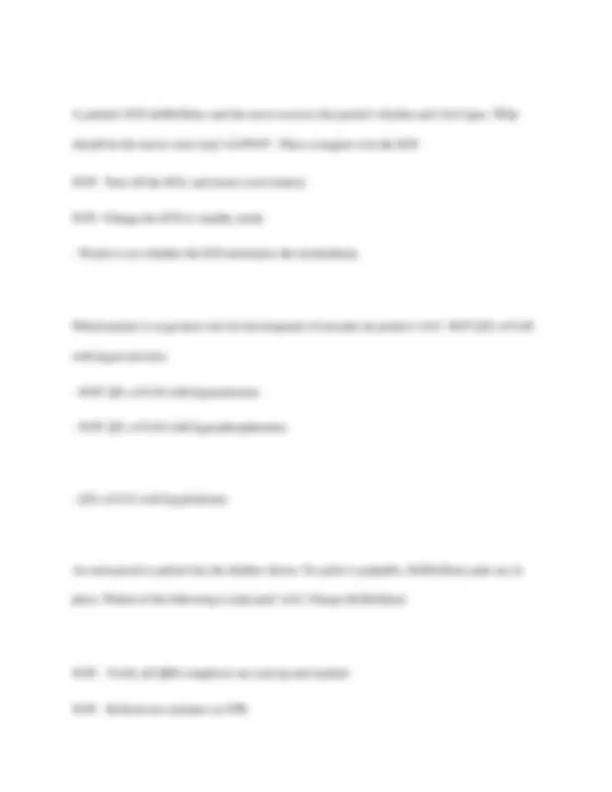








Study with the several resources on Docsity

Earn points by helping other students or get them with a premium plan


Prepare for your exams
Study with the several resources on Docsity

Earn points to download
Earn points by helping other students or get them with a premium plan
Community
Ask the community for help and clear up your study doubts
Discover the best universities in your country according to Docsity users
Free resources
Download our free guides on studying techniques, anxiety management strategies, and thesis advice from Docsity tutors
A patient reports ripping chest pain that radiates to the neck, and shortness of breath. Which interventions should the nurse anticipate? ✔✔NOT - Decrease BP by 50% in 24 hrs NOT - Prepare pt for CT scan with contrast NOT - Administer dyslipidemia agents - Titrate antihypertensives to MAP 60-65 mm Hg A nurse observes a patient's jugular venous distention, tachycardia, and elevated
Typology: Exams
1 / 10

This page cannot be seen from the preview
Don't miss anything!







A patient reports ripping chest pain that radiates to the neck, and shortness of breath. Which interventions should the nurse anticipate? ✔✔NOT - Decrease BP by 50% in 24 hrs
NOT - Prepare pt for CT scan with contrast
NOT - Administer dyslipidemia agents
A nurse observes a patient's jugular venous distention, tachycardia, and elevated CVP. ECHO identifies a large pericardial effusion and onset of atrial collapse. What intervention should the nurse initially anticipate? ✔✔Prepare for pericardiocentesis
You note a wide pacemaker spike followed by a wide QRS complex and a T wave with the opposite deflection on a patient with a temporary transcutaneous pacemaker. ✔✔- Palpate for a pulse corresponding with the QRS
A patient has a transvenous temporary pacemaker in place at a rate of 70 and mA of 5. The patient's rhythm is junctional with a rate of 55. No pacemaker spikes are noted on the ECG. Which is initially indicated? ✔✔- Increase the mA (output)
NOT - Increase the mV on the sensitivity dial
NOT increase mA
Which should the nurse include in preparing a patient for an electrophysiology study? ✔✔- " You will be sedated for the procedure"
Which of these can indicate carotid artery stenosis? ✔✔neurologic dysfunction lasting 1-2 hours
Which are required to assist before and during pericardiocentesis? ✔✔NOT - position flat in bed
NOT - Attach EKG alligator clamp for lead 1 to needle
NOT - Record vital signs every 15 minutes
A patient with a recent MI reports stabbing chest pain that increases with deep breathing and is relieved by leaning forward. SpO2 is 94%. Which should the nurse initially anticipate? ✔✔NOT pericardiocentesis
NOT steroids
NOT Nitro
A nurse notes bradycardia in a patient admitted with subarachnoid hemorrhage and vomiting. What medications may increase the patient's risk of sudden cardiac death? ✔✔- Antibiotics or Antidysrhythmics
What should be the nurse's priorities in caring for a patient after surgical repair of a thoracic Type A dissection? ✔✔- Manage hypertension aggressively to prevent rupture
What should a nurse's priorities be in caring for a patient post-carotid endarterectomy? ✔✔- Assess cranial nerve functioning
A new nurse asks why it is important to check the pacing threshold on a patient with a temporary transcutaneous pacemaker. The best response is, "We need to..." ✔✔- Know the amount of energy needed to trigger depolarization
A patient with repair of the descending aorta is at risk for which of the following? ✔✔- Spinal ischemia
NOT - Renal Artery Stenosis
NOT - Mitral Stenosis
NOT - Unstable Angina
A nurse finds a patient unresponsive and without a palpable pulse. Which of the following assessments is an indication for defibrillation? ✔✔- Ventricular fibrillation
NOT - Asystole
NOT - Cyanosis
NOT - Pulse Ox below 80
Which patient has indications for synchronized cardioversion? A patient with: ✔✔YES - Supraventricular tachycardia with chest pain (Unstable pts)
NOT - Sinus Bradycardia with mental status changes
Which of the following is an accurate statement about temporary transcutaneous pacing? ✔✔It is indicated for symptomatic bradycardia unresponsive to meds
A patient with a history of cocaine use reports headache, blurred vision, severe chest pain, nausea, and vomiting. Vital signs are: BP 214/136, HR 106, RR 24. Which priority is initially indicated? ✔✔- Administration of Nitroprusside (Nipride)
The initial symptoms of a patient with myocarditis have been stabilized. What additional treatment should the nurse anticipate? ✔✔- Administer antibiotic or anti fungal meds
NOT - Enforce bed rest for 24 to 36 hrs
A patient with a history of CAD reports sudden, steady abdominal pain. The nurse finds faintly palpable pedal pulses bilaterally, right popliteal BP 94/46 (62), and left 87/38 (54). What should the nurse do next? ✔✔- Evaluate medications for bleeding risk
NOT- Perform passive leg-raise maneuver
NOT - Request order for chest x-ray
NOT - Monitor intra-abdominal pressure
A patient reports sudden onset of chest pain, and dyspnea. Which assessment would differentiate whether the cause is ACS or pericarditis? ✔✔- ACS chest pain doesn't alter when pts changes position
All but headache
NOT - Assure SYNC switches is activated